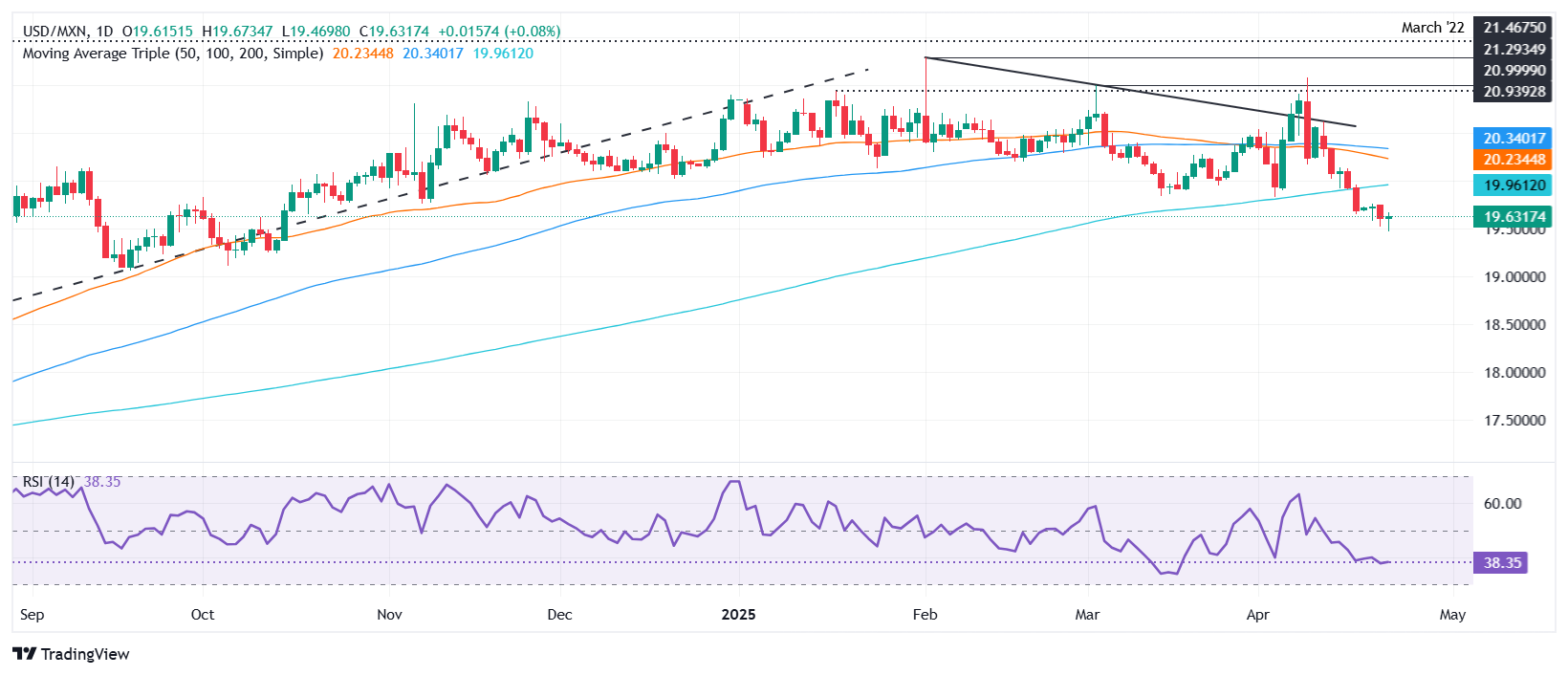Mexican Peso slips as Trump softens stance on Powell, China duties
- Mexican Peso weakens 0.29% vs USD amid return of Greenback strength and improving market sentiment.
- Trump says he won’t remove Fed Chair Powell, easing investor concerns over central bank independence.
- Mexican Retail Sales disappoint; Citi survey shows trimmed growth, stable Banxico rate cut expectations.
The Mexican Peso (MXN) registered modest losses against the US Dollar (USD) on Wednesday amid an improvement in risk appetite and regained confidence in the Greenback as US President Donald Trump denied that he would remove Federal Reserve (Fed) Chair Jerome Powell. At the time of writing, the USD/MXN trades at 19.65, up 0.29%.
The markets remain digesting recent news that US President Donald Trump tempered his attacks on Powell alongside softening its tariff stance on China, aiming to strike a deal with Beijing. The Wall Street Journal revealed that Washington is considering reducing duties on China, though Trump warned that “it wouldn’t be zero.”
Wall Street cheered the breaking news, though later US Treasury Secretary Scott Bessent commented that Trump has not offered to lower tariffs on China unilaterally.
In Mexico, Retail Sales in February were lower than expected, according to monthly and annual data from the Instituto Nacional de Estadistica Geografia e Informatica (INEGI). Meanwhile, Citi Mexico revealed its latest expectations survey, in which 34 economists updated their forecasts on economic growth, inflation, the USD/MXN exchange rate and Banco de Mexico (Banxico) monetary policy.
Ahead in Mexico’s economic docket traders brace for the release of Mid-month inflation, and Economic Activity data.
Daily digest market movers: Mexican Peso loses steam as economists expect Banxico’s cut
- The central bank divergence between Banco de Mexico (Banxico) and the Fed favors further upside in USD/MXN. Banxico’s Governing Council expressed its decision to continue easing the policy. Conversely, the Fed is considered cautious, as some officials have shown concerns about a reacceleration of inflation spurred by tariffs.
- Mexico’s Retail Sales in February dipped from 0.7% to 0.2% MoM, beneath forecasts for a 0.3% increase. In the 12 months to February, sales plunged from 2.7% to -1.1%, showcasing the ongoing economic slowdown.
- Citi Mexico's expectations survey shows that economists expect Banxico to cut its rate by 50 basis points at the May meeting. For the full year, they project the main reference rate to end near 7.75%.
- Regarding the USD/MXN exchange rate, private analysts see the exotic pair finishing at 20.93, up from 20.90. Inflation in 2025 is projected to finish at 3.78%, with core figures at 3.80%, mostly aligned with the previous poll.
- Mexico’s economy is expected to grow 0.2% in 2025, below the 0.3% projected in the prior survey.
- Mexico’s Mid-month inflation in April is expected to rise from 3.67% to 3.79% YoY and core figures to increase from 3.56% to 3.77% YoY.
USD/MXN technical outlook: Mexican Peso remains bearish as USD/MXN stays below 200-day SMA
Since dropping below the 200-day Simple Moving Average (SMA) of 19.91, the USD/MXN has become bearishly biased, though it has recovered some ground after hitting a year-to-date (YTD) low of 19.46.
Buyers must reclaim the 200-day SMA followed by the 20.00 figure for a bullish resumption. A breach of the latter will expose the confluence of the April 14 high and the 50-day SMA near 20.25-20.29 before testing the 100-day SMA at 20.33.
Conversely, sellers could test 19.50 followed by the current YTD low before the 19.00 mark.

Mexican Peso FAQs
The Mexican Peso (MXN) is the most traded currency among its Latin American peers. Its value is broadly determined by the performance of the Mexican economy, the country’s central bank’s policy, the amount of foreign investment in the country and even the levels of remittances sent by Mexicans who live abroad, particularly in the United States. Geopolitical trends can also move MXN: for example, the process of nearshoring – or the decision by some firms to relocate manufacturing capacity and supply chains closer to their home countries – is also seen as a catalyst for the Mexican currency as the country is considered a key manufacturing hub in the American continent. Another catalyst for MXN is Oil prices as Mexico is a key exporter of the commodity.
The main objective of Mexico’s central bank, also known as Banxico, is to maintain inflation at low and stable levels (at or close to its target of 3%, the midpoint in a tolerance band of between 2% and 4%). To this end, the bank sets an appropriate level of interest rates. When inflation is too high, Banxico will attempt to tame it by raising interest rates, making it more expensive for households and businesses to borrow money, thus cooling demand and the overall economy. Higher interest rates are generally positive for the Mexican Peso (MXN) as they lead to higher yields, making the country a more attractive place for investors. On the contrary, lower interest rates tend to weaken MXN.
Macroeconomic data releases are key to assess the state of the economy and can have an impact on the Mexican Peso (MXN) valuation. A strong Mexican economy, based on high economic growth, low unemployment and high confidence is good for MXN. Not only does it attract more foreign investment but it may encourage the Bank of Mexico (Banxico) to increase interest rates, particularly if this strength comes together with elevated inflation. However, if economic data is weak, MXN is likely to depreciate.
As an emerging-market currency, the Mexican Peso (MXN) tends to strive during risk-on periods, or when investors perceive that broader market risks are low and thus are eager to engage with investments that carry a higher risk. Conversely, MXN tends to weaken at times of market turbulence or economic uncertainty as investors tend to sell higher-risk assets and flee to the more-stable safe havens.

